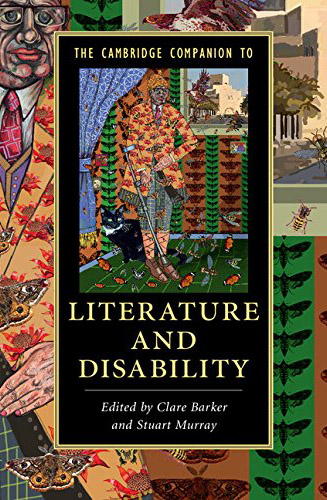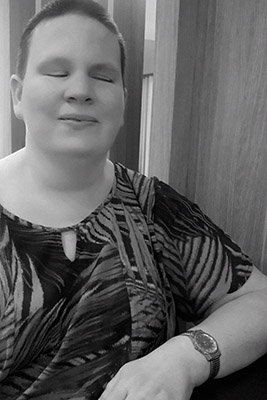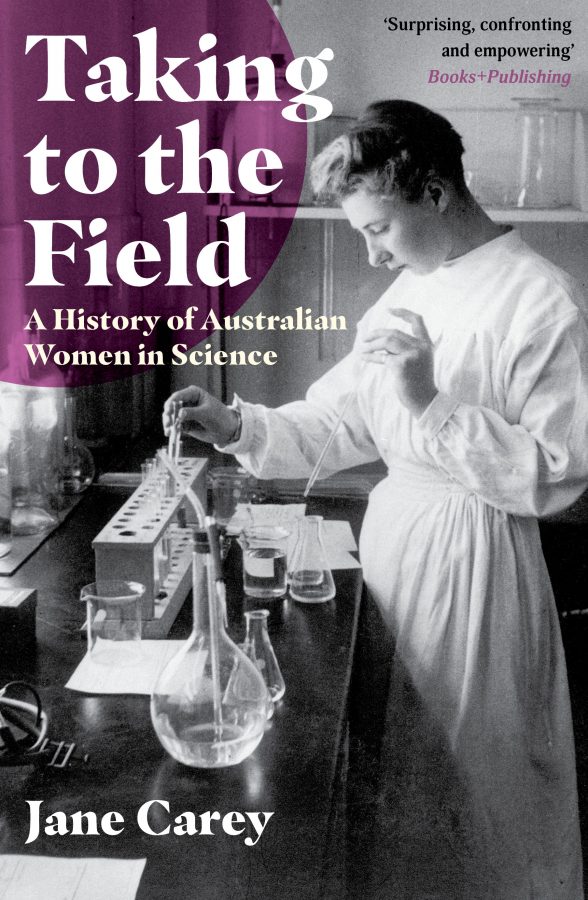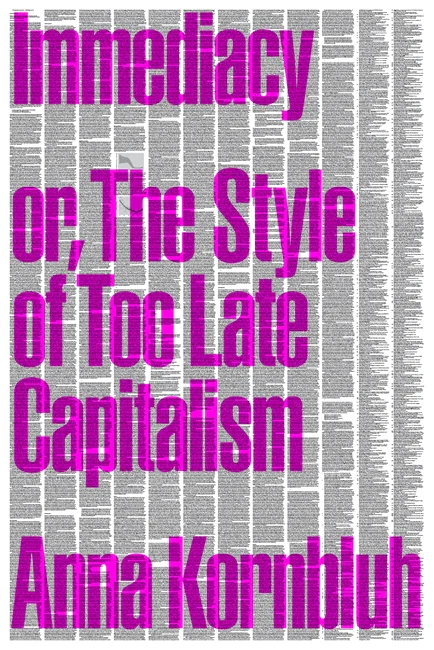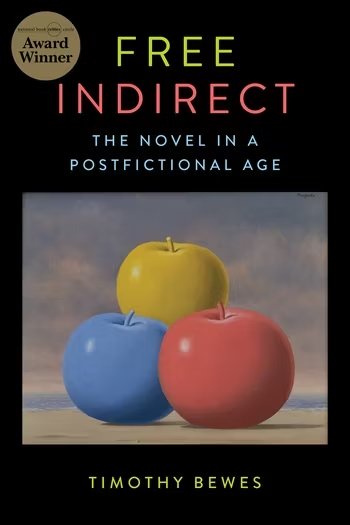One of the high points of my life was the first time I held my very own book in my very own hands. It felt a little less substantial than the books I was reading, but I knew I’d worked hard on these stories about my brother, and it was gratifying to know that it wasn’t just me who found value in them. It was 1985, and I was seven and in Year Three, my first year – and the first year in Queensland primary schools – of what was then called ‘integration’.
A small group of blind students began attending a ‘mainstream’ primary school with a ‘special education unit’ attached, and our time at school was divided between the two in configurations that changed irregularly and without notice in accordance with policy trends we didn’t know about. Even though print was written over my braille, my book wasn’t shown to any other students in my class. It was, however, sent to other blind people at other schools, and I was delighted when they then felt inspired to write their own stories about themselves or their families.
I knew so many blind people who could write, not just children but adults too. Every week or two I received a newsletter from one or other of the state and national blindness organisations, which always included accounts from blind people of events they’d attended, organised, or were planning. I constantly read and enjoyed books too, often three at a time, but there were never any blind people in those; which is to say that blind people didn’t write published books, and sighted people didn’t write blind characters, they wrote sighted characters who couldn’t see.
It wasn’t until I was an adult studying disability studies that I understood the structure of the relationships between these experiences. It’s known as the social model of disability, and was codified in 1975 by a group of disabled activists in the UK. In an effort to address the segregation of disabled people from each other, and from the rest of society, they restructured the language used to describe themselves. Those medical conditions that marked a body as not matching the culture’s standard of ‘normal’ were labelled by doctors as ‘a disability’ or, if you had more than one, ‘disabilities’. With the medical label ‘disability’ came the branding of deficit, the isolation of being a ‘case’, and the expectation that you owed it to society to do all you could to become ‘normal’ (the medical model of disability). Disabled activists renamed those medical conditions impairments, a neutral rather than disempowering term, and used disability to define what they knew from experience to be the real problem – the social conditions that hindered the participation of impaired people in society. In short, the social model says that impaired people are disabled by society. Or, to make a comparison with gender, impairment is biological while disability is sociological.
Forty years have gone by since then, and the social model continuously evolves to incorporate more nuance, such as the idea that impairment, too, is socially constructed. But the shift from disability being a tool used against us, to sever us from the whole and scatter us to the wind, to being our fertile ground of connection, strength and thriving, is the core belief of this field, and distinguishes those who are doing disability studies from those who are simply studying disability.
A note on language: while academics from the UK are likely to use the terms impairment and disability, American academics often use disability to refer to both the biological and the social, and it is not always easy to know which they mean. This is a result of history and culture. Disability activism in the US goes back to the sixties, and has developed around the word disability. Also along cultural lines, academics from the United States usually refer to the practice of treating people with impairments as inferior to people without impairments as ableism, while academics from the UK are likely to call it disablism. Australian language is a mix of both of these, with a lingering dominance of the medical model. I follow the social model, so that’s what you will read in my writing, but the people I’m quoting might use different words to refer to the same thing or vice versa.
The usual examples of an impaired person being disabled by society include a person who uses a wheelchair being disabled by a building designer choosing to construct stairs rather than a ramp, a deaf person being disabled by a cinema choosing to not turn on the captions for a movie, or a blind person being disabled by a presenter choosing to use PowerPoints without either providing a copy of them beforehand or reading them out in real time.
The barriers of my childhood are the less discussed, more surreptitious kind. The message constantly communicated to us was: ‘have a good time writing to each other, while we write fictional, nonfictional, and poetic human histories using our versions of you’. The consequences of this barrier existing for many generations of blind people continue to reverberate. How many Australian blind authors can you name? Even as an Australian disability literature researcher I can only name four – Tilly Aston, Barbara Blackman, Mercy Dickinson, and David Walker. But remember – even before twelve-year old Louis Braille understood that the methods sighted people had devised for blind people to read and write were slowing us down, and that a much better solution was as simple as six dots – blind people have always been writers. Homer figured it out long ago.
It wasn’t until two months before my thirtieth birthday, in 2007, that I first read published writing by a blind person. Given to me by a blind friend who is now my partner, Stephen Kuusisto’s book, Planet of the Blind, resonated with me in a way no other book had. In his 2017 book Every Word Is A Bird We Teach To Sing, Daniel Tammet, an autistic writer and translator from England, writes of Les Murray that ‘Without Murray’s poems, I might never have become a writer. At the time, so early in my adulthood, their oddness reassured. I could see myself in them.’ And so it was of me and Kuusisto. Across our different ages, genders, sexualities, and even levels of blindness, I recognised myself. Finally, I had proof that blind people and creative writing weren’t a mismatch. Planet of the Blind prompted me to write more than just the facts of my experiences, to write those facts in fresh ways, and to research Australian disability literature.
Literary studies, as an area of disability studies, had taken off only ten years earlier, analysing the ways in which nondisabled writers had written fictionally and poetically about disabled people. My interest came at a time when some scholars were turning to researching the literary practices of disabled writers. People like Rosemarie Garland-Thomson, Jim Ferris, Robert McRuer, Petra Kuppers, and Michael Davidson, began investigating the writing of disabled Americans, and how their writing was shaped by their embodiment. And so, another decade on, it’s heartening to know our field is consequential enough to warrant a significant reference work.
The Cambridge Companion to Literature and Disability comprises fourteen chapters, as well as an Introduction and an Afterword, and has been compiled with undergraduate literature students in mind. All contributors have at least one book to their name and, with the exception of one Canadian, are academics at British or US universities. The editors, Clare Barker and Stuart Murray, have structured the book as two parts: the first aims to ‘ground the reader in the ways in which disability representation has worked in specific temporal moments and geocultural locations’; the second responds to ‘the particular directions and parameters of contemporary disability representation.’ As a whole, Barker and Murray state that the book demonstrates ‘the multiplicities inherent within disability experiences.’
With the exception of Barker’s chapter on postcolonial writing, the writers discussed in this collection are either from the UK, with an occasional bonus European, or from the US, with a Canadian or Mexican writer making an appearance every now and then. That said, in the first half of the book, the representation of disability in UK or US-centric literature is thoroughly outlined from the twelfth century to the present. I imagine most people will only read the chapter relevant to the time period they research or that particularly interests them, but I would encourage a wider approach. I recommend this not only to add context, but because the general method of this half of the book is to use an extended definition of each period. With most chapters thereby overlapping with those on both sides, we get the benefit of multiple perspectives on some significant themes and writers. For example, the trope of disabled people as monsters is discussed in the second chapter on medieval literature, the third chapter on early modern literature, and the fourth chapter on the eighteenth century; while Virginia Woolf’s writing is discussed in the sixth chapter on modern literature, and the seventh chapter on contemporary literature.
While the details change with the times, the representation of disabled people over the centuries remains remarkably constant. In 1997, two of the key writers in literary disability studies, David Mitchell and Sharon Snyder, named this type of representation ‘narrative prosthesis’. Their book Narrative Prosthesis: Disability and the Dependencies of Discourse (2000) describes in detail what it is and how it operates. As Michael Davidson puts it in his chapter, Mitchell and Snyder argue that disability is a ‘crutch upon which literary narratives lean for their representational power, disruptive potentiality, and analytical insight.’
Narrative prosthesis occurs when writers give a character an impairment, which simply functions as a narrative reminder of a personality flaw: blindness represents a person’s refusal to believe information that other characters think is important; atypically shaped bodies represent a person’s duplicitousness, mental illness represents the character’s (usually a female character’s) inability to perform the narrative’s prized social role, such as participating in public life. With this structure in place, the narrative sets out to assure nondisabled readers of their normalcy, either by the disabled character (because there’s rarely more than one) overcoming their impairment, or their impairment overcoming them. Following in Mitchel and Snyder’s, and many other disability studies researchers’ footsteps, I’ll list Richard III, and Ahab in Moby Dick, as examples, but you have no doubt already thought of plenty of your own and are struggling to think of a counterexample. This book does provide counterexamples but also demonstrates how few there are.
To be clear, Mitchell and Snyder are not saying disabled people shouldn’t use prostheses; they are saying disabled people should not be used as prostheses, since prostheses are objects, and disabled people are people. This means two things: being a disabled person is a valid identity in itself, and therefore writers need to think beyond just curing or killing characters with impairments. Also that writers need to keep in mind that disabled people are constantly having to contend with the material consequences of being prosthesised. I frequently have to explain to sighted people that blind people can in fact read books, use computers, and travel independently – all assumptions that they most often then attribute to having read it, or not read it, in a novel. These are the kind of assumptions that lead to blind people being denied experiences, responsibilities, and jobs. Similarly, I have many blind friends who are forced by strangers, friends, bureaucrats and employers to explain that their ability to see some things does not mean they are faking being blind. Contrary to the almost universal depiction of blindness in literature, only a tiny percentage of blind people are completely blind. Blindness is, like autism (and all other impairments for that matter), a spectrum.
Mitchell and Snyder are also not saying that beginning with the idea that, say, a character who is a dyslexic writer would make for a great short story, is inherently problematic. They are saying that any literary character should be a real character, not an object; which means constructing disabled characters from understanding disability history, culture, and experience, rather than a collection of stereotypes. Perhaps the most famous example of a nondisabled person writing a disabled character from comprehensive research is Mark Medoff’s play Children of a Lesser God (1979). It was a portrayal of communication between deaf and hearing people, whose point, that hearing people rarely listen to deaf people, was conclusively proved by all the critics who insisted on interpreting it as an analogy for communication between men and women. An Australian example is Emma Viskic’s Caleb Zelic crime thriller series. Once Viskic decided her main character would be deaf, she spent five years researching being deaf, including learning Auslan. As she describes it: ‘Caleb was deaf, not hearing, and unless I wrote him that way, I couldn’t write the novel.’
If narrative prosthesis, or reading a whole book about it, sounds too complicated, a quick formula that both simplifies and extends on it is the Fries Test. Invented by Kenny Fries, a disabled writer and academic, the Fries test is modelled on the Bechdel test for the representation of women in movies. When reading a book ask yourself: ‘Does a work have more than one disabled character? Do the disabled characters have their own narrative purpose other than the education and profit of a nondisabled character? Is the character’s disability not eradicated either by curing or killing?’ Passing the test requires a yes to all three.
The other thing a reader will learn from the first half of the Cambridge Companion to Literature and Disability is the quantity and variety of cultural work disabled characters are co-opted to perform. If a group wants to ostracise another group from society impairment is, and always has been, the key to their strategy. From the twelfth century onwards women, especially if they had what was considered to be too big a sexual appetite, were characterised as monstrous. But then, in the late eighteenth century, from Mary Wollstonecraft on, feminists began using the notion of impairment to assert their strength (relative to what they characterised as the weaknesses of disabled people), and to disparage women who weren’t feminists. In a similar way, and also from the twelfth century, people living in another country from where the author was born are portrayed as either having impairments, or acting in ways that cause their children to be born with impairments, or both. And then, in the twentieth century, colonised people began using impairment both to disparage their colonisers, and to represent the damage inflicted by their colonisers. Impairment is of course also used to ostracise disabled people. Every period includes literature that portrays disabled people as either faking their impairment or faking their skills, and as people who do not deserve to have sex, have children, love, be loved, or even exist.
When nondisabled writers go beyond this propensity to objectify us, they progress into generative terrain that perceives the potential of the nuances of impairment and disability. In their chapter on early modern literature, Allison Hobgood and David Houston cite Thomas Traherne’s ‘Dumnesse’ as a poem exemplifying an aesthetic where ‘impairment is something to be held close, kept integral, and invited to thrive’. Essaka Joshua observes that the picturesque movement in the eighteenth century also values impairment: ‘Theorists of the picturesque reject symmetry, harmony, proportion, and the ideals of perfection, celebrating instead architectural ruins, irregular landscapes, and people whose appearance does not accord with the usual standards for beauty.’ Joshua also refers to Wordsworth a number of times; the poet explores the complexity of impairment and interactions between disabled and nondisabled people, and gives disabled characters equal status with nondisabled characters in his work.
In his chapter on modern literature, Michael Davidson returns to the question which is central to his book Concerto for the Left Hand: Disability and the Defamiliar Body, ‘What would happen if we subjected a poetics of embodiment to the actual bodies and mental conditions of its authors?’ He continues:
Robert Creeley’s lines in “The Immoral Proposition,” “to look at it is more / than it was,” mean something very particular when we know that their author has only one eye. To what extent are Elizabeth Bishop’s numerous references to suffocation and claustrophobia in her poems an outgrowth of a life with severe asthma? Robert Duncan’s phrase “I see always the underside turning” may refer to his interest in theosophy and the occult, but it also derives from the poet’s visual disorder, in which one eye sees the near and the other far. Was William Carlos Williams’s development of the triadic stepped foot in his later career a dimension of his prosody or a typographical response to speech disorders resulting from a series of strokes? It is worth remembering that the signature poem of the era [the 1960s] was not only a poem about the madness of the best minds of the poet’s generation, but about the carceral and therapeutic controls that defined those minds as mad, written by someone who was himself “expelled from the academies for crazy.”’
A reader might at this point wonder exactly what counts as an impairment and what doesn’t. The answer, like race, gender, and sexuality is that it depends on who’s counting. It is in part culturally and historically decided – as gay people, who were classified as impaired by the Diagnostic and Statistical Manual of Mental Disorders until 1975, and transgender people, who are currently classified as impaired but, I’m guessing, probably won’t be in a DSM or two, know well. Currently in Australia, for government and other bureaucratic purposes, being declared disabled requires certification from a doctor, as well as being assessed by a set of criteria specific to the program to which one is applying, and that assessment rarely counts for anything else, even between Australian government departments.
As far as other disabled people are concerned, however, how you self-identify is significant. This doesn’t mean that, like Don Burke, you can appropriate a condition on the spot in an attempt to explain away inappropriate behaviour but, like queer people, if you say you are disabled, then you are. I personally think you are disabled if your body is sufficiently different from the standard to enable a nonstandard perspective; and if your condition either means you are discriminated against, or you conceal it to avoid discrimination.
The second half of the Cambridge Companion to Literature and Disability makes a concerted case for the value of intersectionality, written from different identity perspectives. One chapter addresses the theory of intersectionality itself, followed by chapters on disability and queerness, disability and race, and disability and women. In academia and activism, intersectionality is a site of ongoing debate within and between minoritised groups. I have always thought of disability’s relationships with other minorities as uneasy but vital. There is tension in the fact that so many of us are part of more than one minoritised group and have different experiences with either separating or combining them. And there’s tension with all other minorities, that starts with their need to escape being labelled as disabled at some point in their history, having resorted to some form of ‘discriminate against the truly disabled people, not us’. There’s strength in understanding how, to quote Rosemary Garland-Thomson (from Sami Schalk’s chapter on disability and women), ‘this aggregate of systems operates together, yet distinctly, to support an imaginary norm and structure the relations that grant power, privilege, and status to that norm.’ I would add, there’s strength in the shared experience of surviving oppression, and strength in the creativity that shared experience can give rise to.
I found Alison Kafer and Eunjung Kim’s chapter on intersectional theory to be a troubling start to this section. They begin with a list of some of the responses of disability studies to intersectionality and the reasons they are all inadequate which, for the most part, I agree with. They then suggest two intersectional writers as models for disability studies – Michelle Cliff and Audre Lorde. The authors assert that Cliff and Lorde demonstrate that ‘we can address illness and disability as sites for mutually transformative relations rather than prioritising or isolating disability and disability studies.’ However, they note without criticism that Cliff’s work ‘reveals intertwined lessons about disability as well’ – even though Cliff only discusses ‘lines of color and class’, and even though Lorde ‘seemed aware of how race and disability labels could be used to justify the oppression of other groups, as evidenced by her rumination on “powerful women,”’, but ‘drew heavily on disability metaphors herself.’ To me these are both examples of isolating disability. More concerningly still, neither Cliff nor Lorde, at least on this account, demonstrate to disabled or nondisabled people the richness that disability brings to intersectional contexts.
Sami Schalk’s chapter on disability and women has the opposite problem. It describes how women’s bodies have been defined throughout history as inferior to men’s bodies, argues that feminist disability studies can identify disablism in women’s literature, counters the ideas that bodies should be ranked, and that impairment or disability should be used as a metaphor, and lists a number of talented disabled women writers. In doing so she makes a compelling case for what a disabled perspective offers feminist studies. What she does not do is provide a case for what feminist studies offers disability studies. I have no doubt that it does – feminist disability studies is a strong strand of disability studies as a whole – but that case is not made here. A more balanced view of two critical categories working together is found in Michelle Jarman’s chapter on race and disability. Through literature on enslavement, eugenics, and current injustice, Jarman draws out the ways in which each theory supports, displaces, and is used against, the other.
The stand-out chapter in this group, though, is Robert McRuer’s chapter on disability and queerness. Like Jarman he presents a compelling case for what queerness and disability have to offer each other. But he goes beyond what they offer each other to what they have in common and, by doing so, and through examples including memoirs and documentaries, a ‘”porn star academic”’, ‘”informed beauty”’, and current online campaigns, McRuer convinces readers of the indivisibility of crip/queerness. As McRuer describes it: ‘All of these forms of crip/queer cultural production are about imagining otherwise, of replacing the impoverished representations we have been bequeathed by an ableist and homophobic culture with something more generative.’
The other reason this chapter is a stand-out in the book is that it is only one of two chapters that gives prominence to disabled writers. Its focus is ‘crip lit’ which, as McRuer says, is ‘edgy’, ‘thoroughly queer, in all its valences’, and ‘rejects mainstream culture’s ableist belief that disability is neither desirable nor desiring’. The other is G. Thomas Couser’s chapter on life writing, which mentions some memoirs of family members of disabled people, but otherwise concentrates on disabled memoirists (beginning with one of the first disabled memoirists, published in 1754), highlighting general themes and trends. Speaking as someone who’s followed Couser’s writing, this chapter is an impressive condensation of both the history of disabled memoir and his twenty years of researching this topic. Notable, also, is Schalk’s chapter on disability and women which, although it leaves disabled writers to the end, lists a number and variety of them. She also makes the crucial point that ‘Nonfictional life writing is not, however, the totality of disabled women writers’ work. There are many contemporary disabled women poets, playwrights, and fiction writers, such as Laura Hershey, Jillian Wiese, and Susan Nussbaum’. To these American examples, we could add the following Australian writers: Judith Wright (hearing impairment), Donna Williams (autism), Gaele Sobott (muscular dystrophy), Jacky French (dyslexia), Sandy Jeffs (schizophrenia), Gayle Kennedy (polio), Jessica White (deaf), Gillian Mears (multiple sclerosis), Fiona Wright (eating disorder), and Anna Spargo-Ryan (anxiety).
Disappointingly, however, the majority of chapters in the Cambridge Companion to Literature and Disability, continue the erasure of disability from literary history that is already so prevalent in culture. Overall the book fosters the impression that disabled people either don’t write much, or don’t write much of value. Of the three remaining chapters in the second half that are directly about literature, one doesn’t mention disabled writers at all, the second mentions one, and the third mentions two. The first half of the book includes far fewer disabled writers: three of the seven chapters, as well as the introduction, don’t mention any disabled writers. The remaining chapters again each only mention a few; although Essaka Joshua’s chapter is notable for weaving them throughout her chapter, thereby making them part of the eighteenth century fabric; and Michael Davidson’s for beginning with disabled writers of modern literature.
Whatever the reason might be for this serious omission, it’s not a lack of disabled writers. If I limit myself to poetry and fiction, and stick to the US and UK as the contributors to this book have, neglected options include: Aelred of Rievaulx (arthritis), Milton (blind), Byron (club foot), Samuel Johnson (blind), Emily Dickinson (epilepsy), James Joyce (blind), F. Scott Fitzgerald (dyslexia), Lewis Carroll (autism), W. B. Yeats (dyslexia), Flannery O’Connor (lupus), Christy Brown (cerebral palsy), Joan Didion (multiple sclerosis), and Arthur C. Clarke (polio). In Australia, in addition to the women I listed earlier, disabled writers include: Henry Lawson (deaf), Francis Webb (schizophrenia), Alan Marshall (polio), Lex Banning (cerebral palsy), Les Murray (autism, Hearing impairment, depression), Peter Boyle (polio), Luke Davies (addiction), Mal McKimmie (epilepsy), Andy Jackson (Marfan syndrome), and Michael Uniacke (deaf).
Erasing our history, especially from an undergraduate textbook, has serious consequences. It provides authoritative evidence to undergraduate literature students, and the people who teach them, that disabled people either can’t or shouldn’t write, reinforcing that already common cultural message. Some of these students and lecturers are current or future writers, editors, publishers, or critics. All of them are either disabled or know someone who is.
It’s true that this is the Cambridge Companion to Literature and Disability – not the Cambridge Companion to Disability Literature. Therefore certainly the representation of disabled people is an important topic, and one to survey meticulously. And I want to be clear that this is indeed an excellent collection of writing on representation. However, representation is not ‘the multiplicities inherent within disability experiences’ that the introduction promises. The only source of disability experience is disabled people, who have a literature which, even though it already seems plentiful and rich, will only become more so, since there is still so much of it to uncover.
